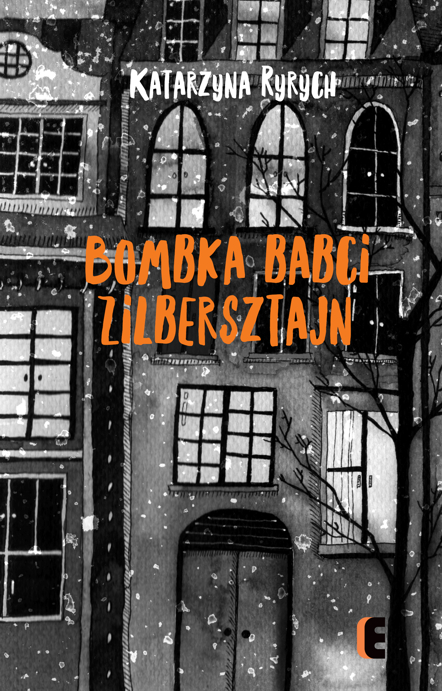Title of the work
Country of the First Edition
Country/countries of popularity
Original Language
First Edition Date
First Edition Details
Katarzyna Ryrych, Bombka babci Zilbersztajn. Warszawa: EZOP, 2018, 160 pp.
ISBN
Genre
Horror fiction
Novels
Time-Slip Fantasy*
Target Audience
Children (and crossover )
Cover

Courtesy of the publisher.
Author of the Entry:
Krzysztof Rybak, University of Warsaw, rybak.km@gmail.com
Peer-reviewer of the Entry:
Elżbieta Olechowska, University of Warsaw, elzbieta.olechowska@gmail.com
Elizabeth Hale, University of New England, ehale@une.edu.au

Anna Rudka
, b. 1989
(Illustrator)
Anna Rudka (1989– ) is a Polish illustrator, comic artist and designer; she graduated from the Faculty of Arts, Kazimierz Pulaski University of Technology and Humanities in Radom. Rudka also illustrated another of Ryrych’s horror children’s books Siódma piszczałka [The Seventh Pipe]. More on Rudka’s official Facebook page (accessed: January 21, 2020).
Bio prepared by Krzysztof Rybak, University of Warsaw, rybak.km@gmail.com

Katarzyna Ryrych by Wydawnictwo Literatura, 2020. Retrieved from Wikimedia Commons, licensed under CC BY-SA 4.0 (accessed: December 21, 2021).
Katarzyna Ryrych
, b. 1959
(Author)
Katarzyna Ryrych (1959) graduated in English Philology at the Jagiellonian University in Kraków, Poland. She is a painter, translator and author writing for adults and children. Many of her works received awards, including Siedem sowich piór [Seven Owl’s Feathers] from 2008, Łopianowe pole [The Burdock Field] from 2017 (Polish IBBY Section "Book of the Year" Award), Wyspa mojej siostry [My Sister’s Island] from 2011 ("ABCXXXI – Cała Polska czyta dzieciom" Foundation’s Astrid Lindgren Award, listed on the IBBY Outstanding Books for Young People with Disabilities) and O Stephenie Hawkingu, czarnej dziurze i myszach podpodłogowych [About Stephen Hawking, the Black Hole, and Under the Floor Mice] from 2013 ("ABCXXXI – Cała Polska czyta dzieciom" Foundation’s Astrid Lindgren Award, Kornel Makuszyński Literary Award).
Sources:
Profile at wydawnictwoliteratura.pl (accessed: December 6, 2018).
Profile at ibby.pl (accessed: December 6, 2018).
"ABCXXXI – Cała Polska czyta dzieciom" Foundation’s Astrid Lindgren Award (accessed: December 6, 2018).
Bio prepared by Krzysztof Rybak, University of Warsaw, rybak.km@gmail.com
Summary
Seven year old Ninka moves with her parents and brother Alek to the apartment which belonged to her recently deceased grandmother. The old, damaged building from before WW2 keeps a lot of secrets, exaggerated additionally by Ninka’s fruitful imagination. A huge and loud grandfather clock becomes home for a monster called Tempus Fugit – these words are written over the clock face and, even though it means "time flies" in Latin, Alek convinces his sister it is a name card of a "time-eating" monster (p. 6). At one point the girl distances herself from her brother and parents: the father thinks only about his pregnant wife who remains at a hospital. The only person who pays attention to Ninka is grandma Zilbersztajn, an older neighbour living upstairs who remembers the war. Around Christmas time she gives the young protagonist an old, hand-crafted Christmas bauble. The very same day Ninka discovers a hidden passage behind the coats in her wardrobe. On the other side there is no kind faun Tumnus as in the Chronicles of Narnia by C.S. Lewis but a hungry, terrified girl who doesn’t want to tell her her name. Since making the discovery Ninka meets with the girl and also visits the other side, learning about history of the building and grandma Zilbersztajn. As it turns out, the journey through the wall is also a journey to the past, to the Holocaust, as Ninka talks to the mysterious girl about hiding from persecutors and sees from a small window people stealing things left by victims etc. The novel uses fantasy to present the Holocaust to young readers (more in the analysis), but also it is the very first Polish Holocaust work for children which uses elements of gothic novels and horror.
Analysis
One of the motifs used by the author is a Latin phrase "tempus fugit," often translated into English as "time flies." The phrase comes from Virgil’s Georgics (Verg. G. 3.284) and its meaning is close to "carpe diem” (seize the day) rather than an expression of timeless concepts. In Bombka babci Zilbersztajn this sentence can be interpreted in various ways. On one hand, an old clock decorated with Latin inscription makes gloomy sounds, affecting the sensitive girl and heightening her fear. In addition, the protagonist’s brother Alek explains that the piece of furniture is home to the monster Tempus, which undoubtedly intensifies Nina's feelings. It is clear that children do not know Latin – in a different situation "tempus" would not be a terrifying monster at all, because its "name" would not sound exotic.
However, in the context of the Holocaust which the book of Ryrych is dedicated to, a gloomy clock measuring the time and the words "tempus fugit" gain a new meaning. On the historical level they can be traced to the fate of Jews during World War II, when time was ruthlessly controlled by the Nazis and most often "came out" through the chimneys of extermination camps. On the other hand, on the level of fantasy, one should note the interesting use of time travel motifs, as "tempus fugit" may be understood as running away from one specific time to another (similarly used in The Devil's Arithmetic by Jane Yolen or in a Polish book The Ark of Time by Marcin Szczygielski).
Curiously, both in the titles of the chapters and in the text itself, we encounter well-known nonsensical counting rhymes used by children playing hide and seek, or tag – sometimes modified in a macabre manner, sometimes corresponding to the realities of war counting-out rhymes: "Pałka, zapałka, dwa kije, kto się nie schowa, nie żyje”, "Entliczek, pętliczek, czerwony stoliczek, na kogo wypadnie, na tego bęc”, "Odnajduję, wystukuję, kogo znajdę, zaklepuję”, "Raz dwa trzy, kryjesz ty". Their function acquires additional significance in the context of the analysis of the word "tempus fugit" made so far, because they have the purpose of enumerating, counting down the time, which should lead to a happy start of a play. However, in Bombka babci Zilbersztajn time seems to lead to the tragic end not of a play, but of life.


